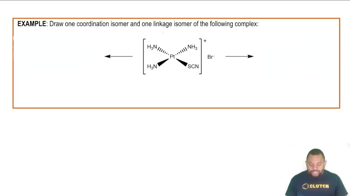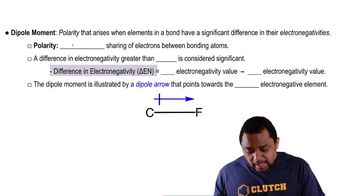Predict whether each of the following molecules is polar or nonpolar: (a) CCl4, (b) NH3, (c) SF4, (d) XeF4, (e) CH3Br, (f) GaH3.
Ch.9 - Molecular Geometry and Bonding Theories
Chapter 9, Problem 44
Dihydroxybenzene, C6H6O2, exists in three forms (isomers) called ortho, meta, and para:

Which of these has a nonzero dipole moment?
 Verified step by step guidance
Verified step by step guidance1
Identify the three isomers of dihydroxybenzene: ortho, meta, and para.
Understand that a molecule has a nonzero dipole moment if the individual bond dipoles do not cancel each other out.
Analyze the structure of ortho-dihydroxybenzene: the hydroxyl groups are adjacent, leading to a nonzero dipole moment due to the asymmetrical arrangement.
Analyze the structure of meta-dihydroxybenzene: the hydroxyl groups are separated by one carbon, leading to a nonzero dipole moment due to the asymmetrical arrangement.
Analyze the structure of para-dihydroxybenzene: the hydroxyl groups are opposite each other, leading to a zero dipole moment as the bond dipoles cancel each other out.

Verified video answer for a similar problem:
This video solution was recommended by our tutors as helpful for the problem above.
Video duration:
1mWas this helpful?
Key Concepts
Here are the essential concepts you must grasp in order to answer the question correctly.
Isomerism
Isomerism refers to the phenomenon where compounds have the same molecular formula but different structural arrangements. In the case of dihydroxybenzene, the ortho, meta, and para isomers differ in the positions of the hydroxyl (-OH) groups on the benzene ring, leading to distinct physical and chemical properties, including dipole moments.
Recommended video:
Guided course

Isomerism in Coordination Complexes Example
Dipole Moment
A dipole moment is a measure of the separation of positive and negative charges in a molecule, indicating its polarity. Molecules with a nonzero dipole moment have an uneven distribution of electron density, resulting in a positive and a negative end. The orientation and arrangement of functional groups in isomers can significantly affect their dipole moments.
Recommended video:
Guided course

Dipole Moment
Molecular Geometry
Molecular geometry describes the three-dimensional arrangement of atoms within a molecule. The spatial arrangement of atoms in ortho, meta, and para isomers of dihydroxybenzene influences their dipole moments. For instance, the ortho and meta isomers can exhibit nonzero dipole moments due to their asymmetrical structures, while the para isomer is symmetrical and typically has a zero dipole moment.
Recommended video:
Guided course

Molecular Geometry with Two Electron Groups
Related Practice
Textbook Question
Textbook Question
Dichloroethylene (C2H2Cl2) has three forms (isomers), each of which is a different substance. (b) Which of these isomers has a zero dipole moment?
Textbook Question
Dichloroethylene (C2H2Cl2) has three forms (isomers), each of which is a different substance. (c) How many isomeric forms can chloroethylene, C2H3Cl, have? Would they be expected to have dipole moments?
Textbook Question
Draw sketches illustrating the overlap between the following orbitals on two atoms: (a) the 2s orbital on each atom
Textbook Question
Draw sketches illustrating the overlap between the following orbitals on two atoms: (b) the 2pz orbital on each atom (assume both atoms are on the z-axis) (c) the 2s orbital on one atom and the 2pz orbital on the other atom.
2
views
1
rank
